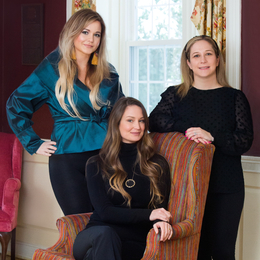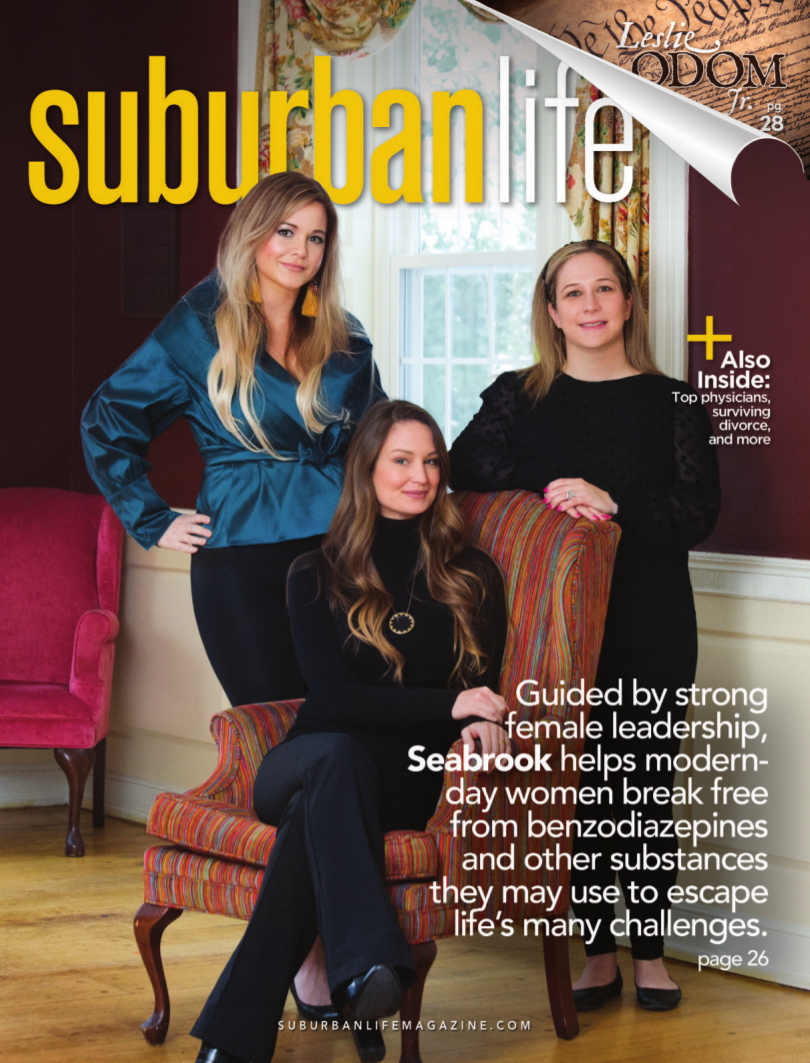
Parting Ways with ‘Mother’s Little Helper’
Modern-day women who use benzodiazepines and other substances to escape from life’s many challenges turn to Seabrook for help in breaking the hold of addiction.
Being a mother isn’t easy on the best of days, let alone during a snowy winter 11 months into the uncharted chaos of a global health crisis. Children are getting their education at home, either full- or part-time, and many spouses enjoy work-from-home privileges. In other words, “family togetherness” has become a 24-7 affair.
Combine this dynamic with the pressure women have to be selfless and courageous maintainers of households, warrior-caretakers who wear an outward appearance of calm and control no matter what may be happening within, and it becomes clear that women in 2021 face challenges on an unprecedented scale. To cope, some seek a temporary escape in the form of substances—alcohol or drugs such as benzodiazepines, including lorazepam (Ativan), diazepam (Valium), and alprazolam (Xanax)—but often discover the perils of doing so.
“In my opinion, with the present reality, women are finding ourselves a lot more stressed than was typical before,” says Gina Marchando, DMFT, LMFT, the CEO of Seabrook, a local addiction treatment facility owned by Summit Behavioral Healthcare. “Everyone has been doing their best, but what was initially two weeks, then a month, is now going into close to a year.
“Women have had to make adjustments to their working schedules; a spouse or partner may have lost a job, and one or both partners are now caring for children as well as schooling partially or full-time at home,” she continues. “Daycares have been equally affected, and normal activities women would turn to for self-care have been closed for a long time now. A lot of people are living in fear.”
Dr. Marchando references a 2017 report from the U.S. Centers for Disease Control and Prevention to share some truly sobering figures: Between 1999 and 2017, the number of women ages 30 to 64 who have experienced benzodiazepine (“benzo,” as it’s known) overdose rose rapidly, as did prescriptions for these drugs, which rose by 67 percent.
Benzodiazepines are intended for short-term use of only two to four weeks, for the most part. Yet, these medicines are so powerful that when a person experiences the flood of temporary chemical relief associated with the drugs, the seeds of psychological addiction are sown.
“The idea of ‘mother’s little helper’ has always been a socially constructed joke,” Dr. Marchando shares. “Valium, Xanax, Klonopin, Ativan, or whatever the drug du jour is. All of a sudden, someone who never had a drug problem experiences insomnia, stress, and even more anxiety.”
“Most women don’t even realize they have an addiction to a benzodiazepine because it’s prescribed by their doctor,” adds Rosemarie Wells, Outpatient Admissions Coordinator. “We have a lot of women come in with alcohol as their substance of choice, and then we find out they are also using benzodiazepines as well. A lot of women are shocked to find out the addictive nature of benzodiazepines because they are easily obtainable from their doctor.”
Megan E. Crooke, Director of Business Development at Seabrook, notes that the shift in parents’ roles as caretakers has increased anxiety for many mothers.
“It’s understandable that a person would say to a doctor, especially during a time like this, ‘I’m stressed and have anxiety,’” Crooke says. “In response, many doctors are handing out prescriptions, and when a person experiences immediate relief, that’s something that’s hard to turn away from.
“At Seabrook, our team is currently led by a number of women who are also educated wives, partners, and mothers with careers, looking to thrive,” she continues. “I think this makes us uniquely equipped to help other women. We understand the position they’re in because we’re there, too.”
Finding Relief
The question, “Do I have a problem?” may be the first indicator it is time to look into treatment options such as Seabrook House, which offers multiple treatment modalities for those looking to break free from the bondage of addiction.
“Signs of problematic use can include ‘doctor shopping’ or ‘borrowing’ prescribed pills from friends,” Dr. Marchando says. “It’s not uncommon for people who are incredibly high-functioning to look to buy drugs off the street when taking a drug more than prescribed or longer than intended.”
Additional signs of problematic use may include forgetfulness, impaired functioning at school or work, and physiological changes such as chronic headaches, nausea, dry mouth, and sexual dysfunction. Socially, a person with emerging chemical dependence might begin to isolate and withdraw from the company of others. Despite the seriousness of the problem, some refrain from seeking the help they need because of the persistent stigma associating addiction with weakness or failure.
“Secrecy and shame further isolate a person who might function well from 9 to 5, but who then falls apart at 5:05 p.m.,” Dr. Marchando says. “A person will experience blame, shame, and guilt, which breathe life into addiction by perpetuating a toxic spiral. As a society, we have normalized toxic ideas such as the ‘mommy wine culture.’ But how can you ever truly define ‘normal’? ‘Normal’ is a subjective, socially created standard and, when utilized in context with drug or alcohol abuse, is more of an excuse that perpetuates denial and minimization of a problem that truly may be a greater issue.
“We live in an emotionally illiterate society,” she continues. “Women have fought for equal rights for such a long time, and we have made leaps and bounds. With that, however, come pressures like, ‘There are no feelings when it comes to meetings or business.’ A woman might find that, with benzodiazepines or multiple glasses of wine, it’s easier to numb those feelings.”
There is no singular “cause” of addiction. For that reason, Seabrook maps individual therapy plans for each client. Those in inpatient treatment have the opportunity to remove themselves from everyday life stressors, allowing them to focus just on themselves. Furthermore, an introspective, insight-oriented approach to psychotherapy is designed to help the individual identify the key underlying factors that have fueled their addiction. A wellness program offers healthy alternatives to substance use for coping, including mindfulness, meditation, yoga, and acupuncture.
“At Seabrook, we offer outpatient care, as well as a traditional residential 28-day stays and medical stabilization for detoxification,” Dr. Marchando says. “Our comprehensive approach is biopsychosocial, meaning we assess how substances have infiltrated a person’s life. Examining these criteria and a person’s symptomatology, we can plan a course of treatment that might include individual or group outpatient sessions, or an inpatient stay with physician-assisted detoxification to help stabilize a person while all the cells in the body release the person’s drug of choice.”
For anyone who might be fearful of getting the help they need, Dr. Marchando has a message: “When any human is in a period of acute distress, anxiety is normal. We need that anxiety response to recognize danger. But when that anxiety becomes consuming, women and men need to know that there are means of relief—other than a pill.”
For more information, visit www.seabrook.org or call (888) 704-4540.
Photography by Alison Dunlap
Published (and copyrighted) in Suburban Life magazine, February 2021.



